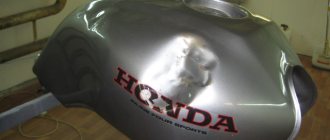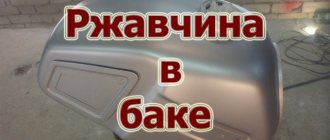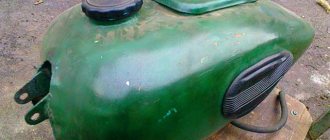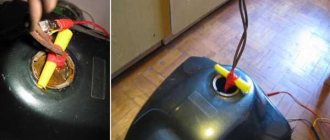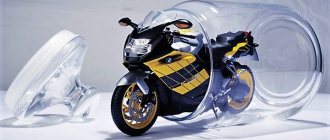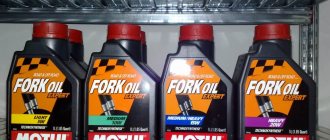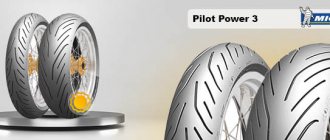For a vehicle to function properly, it must be fueled with high-quality fuel. But even the most highly purified gasoline will not save you from rust in the gas tank if it has already appeared.
To prevent its smallest particles from leaking through the filter and damaging the engine, you need to regularly clean the fuel storage from corrosion.
Read the article on how to clean the inside of a gas tank from rust.
We use acetone
To flush a standard 43–50 liter tank, you will need to prepare 2–3 liters of acetone. The procedure is performed as follows:
- Pour 1 liter of acetone into the dismantled gas tank.
- Close all drain holes and filler cap tightly.
- Shake the container well several times.
- Drain the liquid into a bucket.
- If a large amount of rust and dirt comes out along with acetone, then it is necessary to carry out the procedure one or two more times.
The properties of acetone allow you to efficiently remove rust from any metal surface.
Phosphoric acid converter
Phosphoric acid is a potent chemical; it is recommended to use it outdoors, away from fire and heating appliances.
This converter is used with rubber gloves and safety glasses.
It is not recommended to use orthophosphoric acid in its pure form. If you do not comply with the proportions, you can cause irreparable damage to the fuel tank.
Cleaning the fuel tank yourself - step-by-step instructions for using the converter:
- First you will need to dismantle the tank. Follow this algorithm: remove the terminals from the battery, drain the remaining fuel from your gas tank, disconnect the fuel level sensor and disconnect the ventilation and fuel hoses. All that remains is to unscrew the screws and carefully remove the container. Place the gas tank on a level surface.
- First, wash the inside of the container with hot water. This will help remove large chunks of rust and dirt. Hot water is poured into the gas tank, closed and shaken vigorously. The dirty liquid is poured out and proceed to the next step.
- 500 ml of converter with orthophosphoric acid is poured into the container. The tank is closed and slowly rotated so that the liquid is distributed along the walls.
- Cleaning the gas tank will take 1-2 hours. After 1 hour, you can drain the converter and perform a final flush. If there is a lot of rust, the procedure is repeated.
- The final rinse involves filling the reservoir with water. 100 grams of baking soda are poured there per 10 liters of liquid.
- All that remains is to dry the tank. There should be no liquid left in the gas tank. Drying takes 3–4 hours.
You will have to devote almost the entire day to the procedure to thoroughly clean the gas tanks from rust.
After the converter has washed away all contaminants and the tank has been dried, you can install it in the car.
This method of washing will not leave any trace of corrosion. She won't appear for a long time.
Is it possible to flush the tank with gasoline?
Washing with gasoline (diesel fuel) is a mandatory step in all cleaning procedures. The fact is that after any, even the most thorough washing, a small amount of acid, acetone or washing powder inevitably remains in the gas tank. You cannot install such a tank on a car, because all this sediment will get into the fuel system, and from it into the engine.
Before pouring gasoline, it is recommended to dry the tank with a hairdryer - warm air will quickly dry all corners of the gas tank cavity. It will take a day or more for the container to dry on its own.
Therefore, after completing all cleaning procedures, it is necessary to carry out the last one - rinse the tank with fuel:
- Reinstall the tank.
- Connect all necessary lines.
- Fill the gas tank to the brim with gasoline.
- Close the lid.
- Start the engine and allow the fuel to circulate through the system.
- Add gasoline as it leaves the highways.
Cleaning with water, shot and reagents
To remove rust particles, use a high-pressure water jet. To enhance the effect, you need to throw small metal objects inside, for example, nuts. In addition, you need to purchase a special rust neutralizer. Acetone, thinner or acid will also work.
All work with chemicals should be carried out in a well-ventilated area or outdoors. It is imperative to use personal protective equipment: respirator, goggles, thick rubber gloves.
The procedure is as follows:
- You need to start by removing any remaining fuel and removing the gas tank.
- Pour 2-3 liters of hot water inside.
- Add shot or other filler.
- Shake the tank.
- Drain and repeat the procedure several times.
- Dry the container.
- Prepare the reagent. If you use a purchased regressor, you must follow the directions on the package. The acid is diluted in the amount of 100 milliliters per 1 liter of water, and acetone will need one liter.
- Shake the tank vigorously and do this several times every 2-3 hours.
- Rinse the tank with a solution of water and baking soda in a ratio of 100 g per liter.
- Treat the inner cavity of the tank with clean water.
- Remove the nuts using a magnetic screwdriver.
- Dry the tank.
- Set it in place. If corrosion stains are found on the outer walls, clean them and paint them.
- Fill with fresh fuel.
This technique is quite effective. However, it takes a lot of time to implement it, and if the tank is severely corroded by rust, you can pierce it through with pellets or burn it in weak spots with acid, so old containers should be cleaned using another method.
Water pressure
If you carry out the event frequently, you don’t need to use detergents and acids. It is enough to take a Karcher and rinse the inside of the gas tank with strong water pressure.
This method will save fuel filters from quickly depleting.
How to clean the gas tank:
- Disconnect the tank. Before doing anything, you must disconnect it from your motorcycle or other equipment. Without disconnecting the tank, you will not be able to access it or clean it safely. Unfold the tank and remove the screws or bolts that secure it. For lawn mowers and similar items, the fuel line and spark plugs must be removed.
- Close the fuel line. After disconnecting the fuel line, you need to block the access to gasoline. Dirt or other objects can get into the fuel line and cause problems. Take some kind of smooth clamp and attach it to the line near the carburetor.
- Empty the tank. Pour the remaining fuel into a gasoline-safe container. If you can't get everything out, use a suction hose or similar device to remove the fuel from the tank. Let the tank dry completely. Without draining the remaining fuel you will not be able to clean properly.
- Inspect the tank. Take the time to examine the tank, looking for any problems that could compromise its integrity. Defects, rust, or other problems may pose a potential safety hazard or may jeopardize the proper operation of the engine.
- Turn on the Karcher and spray high pressure water into the tank. It is necessary to treat all surfaces of the gas tank.
At the end of the procedure, it is necessary to dry the container and replace it.
If you are performing the procedure for the first time, take a photo of the disassembly process to make it easier to assemble later.
Carbonated drinks are great for removing limescale and rust. Coca-Cola, Pepsi, Sprite and just sparkling water are suitable for this procedure.
It's better to use Coca-Cola. It contains phosphoric acid, which will clean the container in a matter of minutes.
How to flush the gas tank:
- You will need as much drink as the flammable mixture can accommodate. You can use any carbonated drinks containing phosphoric acid.
- The drink is poured into a container, which you don’t mind spoiling if something happens, and heated to 40 degrees. Warm Coca-Cola effectively removes rust.
- While the drink is on the stove, remove the gas tank and place it in the sun, it should also be warm.
- The heated liquid is poured into the container to the very edges.
- Leave for 2–4 hours. The holding time depends on the degree of contamination. If the gas tank is cleaned once a year, then you can leave the drink in it all night.
Finally, drain the sweet drink and rinse the reservoir.
Cleaning a motorcycle tank from internal rust
Maybe it will be useful for someone... In general, what can I tell you, friends. If you wash your motorcycle tank from rust, don’t repeat my mistakes. :))))) the tank is 25 years old, and apparently it stood empty and rusted for a long time.
Obviously, all previous actions (rust converter, abrasive, solvent) gave a very mediocre result. that is, the rust remains inside the tank. and not just a little, but quite a lot. Which gave me the idea to try a chemist I knew with a soldering iron. The chemist quickly gave up and said that there is such a cool thing -
citric acid... which housewives add to all sorts of goodies. So, if you make a 3% solution of this very acid (hot solution), it will dissolve all the rust. It won’t peel off, won’t scrape off, but rather dissolve. Tank 24 liters. you need 720 grams of citric acid. but I waited and bought 620. The result was a slightly weaker acid. Considering that an 8 gram bag costs 7 rubles, then 620 grams came out fine. In chemical stores, a kilo costs 140 rubles, but for some reason they don’t sell it to private individuals.
So, I filled the tank with this hellish swill as hot as possible from the tap. Of course, first I dissolved all the powder in 2 liters of water (it will be a pain to dissolve in a tank). I left the full hot tank overnight. After 6 hours it had not yet cooled down, but it stood for about 14 hours. In the morning I successfully drained it. Typically, he poured in clear water and poured out yellow-brown water. I washed it with 10 liters of water, shook out the remaining peeling paint - and voila! There is no rust in the tank! only gray metal and remnants of paint. And before that, rust was everywhere. Glory to citric acid!
We suggest you read How to remove glue from a sticker and the sticker itself: from plastic, glass, bottles, clothes, refrigerator or car
So! The correct procedure for cleaning a motorcycle tank is:
1. Drain the gasoline 2. Rinse with water, remove all dirt that has already peeled off and is floating, rinse again with water. 3. Pour a 3% hot (!) solution of citric acid overnight (or until it cools down). The best reaction is in a hot solution. Therefore, you can wrap the tank with a blanket or quilted pad so that it does not cool down so quickly. 4. Drain the acid, rinse the tank with water, possibly with the addition of soda. 5. wash with phosphoric acid or rust converter. Converter according to instructions. The acid creates a film on the surface of the iron that prevents oxidation of the metal (rusting). 6. rinse with water, dry and that’s it. You can use it.
On the forums it is generally recommended that after all these procedures, fill the inside of the tank with epoxy. Think. but even without this, the result exceeded expectations. Thanks to chemists and citric acid!
MY MOTORCYCLE
Rust in the tank - this problem faces owners of mainly old motorcycles. Sooner or later it appears, especially if the equipment is used incorrectly. Yes, and in gasoline now you can find water and other troubles that affect the condition of the metal. So what should we do? We need to clean it! Of course, the filtration system will not allow any more or less large pieces of rust into the carburetors/injector, but sooner or later it will come out sideways!……So let’s look at options for cleaning the tank. I won’t say anything new, but I hope it will be useful to someone.
First, let's look at a couple of the most significant and common ones:
The first method is the “old-fashioned” one. I’ve seen it on many resources, so it’s generally accepted. Further actions depend on how deep the corrosion has eaten into the tank wall. If it is significantly covered with rust from the inside, then you can use a simple and reliable method.
It is necessary to remove the gas tank, drain the remaining gasoline from it, rinse it with water and pour a couple of handfuls of nuts (not large ones) into it. After which we stock up on patience and strength, and begin to shake the tank so that the nuts knock off all the rust from the walls. If desired, you can replace the nuts with pebbles or sand; sometimes the remaining rust is cleaned with sand after the initial treatment of the gas tank with nuts. Fill with gasoline for final rinsing. After washing, drain the mud and see what’s wrong with the tank. If there are still small rust residues left, you can use already proven orthophosphoric acid or special rust converters.
Wikipedia: “Orthophosphoric acid is also used to remove rust from metal surfaces. Forms a protective film on the treated surface, preventing further corrosion.”
Next option: Take the tank, drain the gasoline, blow out or dry the tank with the cap open. When everything is dry, take about 0.5 liters of any rust converter (chemicals), of which there are countless quantities in any auto shop. Alternatively, the same orthophosphoric acid. But be careful with it: don’t breathe or drip on the paintwork. Close the cap and twist the gas tank so that the liquid wets all the inner walls. We wait a little - from 25 minutes to an hour (depending on the temperature) and the whole mess. pour out what has formed. To clean the container from chemical residues, you can rinse it with plain water and baking soda. Soda neutralizes acid residues and softens the water, which washes absolutely everything. But do it carefully. We drain the remaining soda and rinse it with running water, and simply dry the tank.
As a folk remedy, some “Kulibins” take Coca-Cola or something like that (there’s plenty of nonsense), heat it to 35-40 degrees and leave it for a couple of hours. Why this water? The fact is that if you look at the chemical composition, cola also contains orthophosphoric acid, but it is slightly less than in the rust converter. But, as they say, they can eat away everything, including rust. Another interesting fact: all this machmala, along with rust, can be used to clean chrome or tiles with a toilet bowl well.
Let's return to the main options: the “scientific” method. Those who fumble around in physics will quickly grasp it, but the rest either don’t take risks or suffer. School physics course: resort to the help of electrolysis.
Attention - this work causes the release of harmful and flammable gases! They must be carried out in a well-ventilated area!
For this method, you will have to pour the electrolyte solution into the gas tank. Regular washing soda (sodium carbonate) is suitable as an electrolyte. If you can’t find it on sale, you can heat regular baking soda in the oven (160-180 degrees, for about 30-40 minutes). The output is sodium carbonate. Then pour water into the tank and stir the above-mentioned sodium carbonate into it. For 15 liters of gas tank volume you will need approximately five tablespoons.
An electrode is immersed in the resulting electrolyte solution (without touching the walls of the tank - to avoid a short circuit; it is not recommended to use a stainless steel electrode to avoid the release of particularly harmful gases during the electrolysis process). An ordinary ferrous metal, that is, a banal piece of iron or iron wire, will do as the electrode itself.
Then the minus is connected to the gas tank body, and the plus to the electrode. To the body is MINUS (this will be scientifically called CATHODE), and to the electrode is PLUS (ANODE). Rust will begin to disappear from the walls of the tank and materialize on the electrode. The main thing is not to confuse the polarity if you don’t want to corrode the tank into trash! Then we connect direct current and observe the result.
Hydrogen is released at the cathode and oxygen is released at the anode (hence the intense oxidation-corrosion of the electrode). The healing effect occurs due to hydrogen, firstly, it acts like sandblasting from the inside and removes soft rust even where sandblasting could not be reached, and secondly, due to hydrogen, the metal is restored from its oxide (iron oxide - rust), the restoration occurs better if heat is present.
Do not use stainless steel as an electrode, because During electrolysis, a by-product is released - hexavalent chromium, a very unhealthy thing, toxic, carcinogen.
Another option I found online was a guy’s reasoning (sorry, I didn’t write down his name): unscrew the faucet and insert a fitting with an air supply, but the stream should be strong, install a very fine mesh on the side of the tank lid. small. But before that, pour a small fraction of pebbles or sand into the tank. Well, turn it all on! I don’t know how much it will help, but it’s an option.
After cleaning the gas tank from rust using any method, it must be protected from repeated corrosion. The popular method is epoxy resin. It is heated and poured into the tank, after which the tank is rotated by hand until the epoxy covers its inside walls with a thin layer. Once frozen, they form a coating similar in structure to glass. But this method also has a disadvantage - if the motorcycle touches the gas tank against something, the epoxy will break like real glass, and it will take a long and tedious time to remove the fragments from the gas tank. In addition, there have been cases where small fragments of cured epoxy resin entered the fuel system, and the consequences were not very pleasant. Therefore, you can look, again, for something from chemicals for anti-corrosion treatment, like “Kreem”. They have their own application features, but this is a topic for a whole separate article.
Sources: ragingbiker.ru; buccaneer.io.ua/s108250; Wikipedia; opposit.ru; and various motorcycle forums.
Applications of Electrolysis
When electric current passes through a chemical solution, the substance decomposes into its constituent parts. It is this property that is used when cleaning the fuel tank from corrosion using this technique. To carry out the electrical procedure you will need:
- Caustic soda.
- Battery or charger.
- Metal conductor.
- Water.
The room must have a good ventilation system due to the explosiveness of the mixture of hydrogen and oxygen formed as a result of electrolysis. It would be optimal to hold the event outdoors.
It is recommended to steam the tank before starting cleaning. To do this, you can use a steam generator or the traditional method. You need to put a hose on the exhaust pipe, the second end of which is inserted into the neck of the container. Drying should be carried out for 15-20 minutes at idle speed. You can also use this technique when welding cracks in a gas tank.
Electrochemical cleaning should be carried out using thick rubber gloves and avoid getting the solution on exposed skin, since caustic is a strong alkali and causes burns to the body. If you come into contact with this solution, the affected area should be rinsed generously with clean water.
We suggest you familiarize yourself with How to smooth out paper, crumpled money, a notebook with and without an iron?
A short guide to electrolysis:
- Mix one glass of caustic soda in 30 liters of water.
- Fill the tank 90 percent with solution.
- Insert the conductor inside to the bottom without touching the walls. You can cut a wooden or plastic plug to fit the diameter of the neck and place this electrode in the middle.
- Connect the wire to the minus of the battery, and the cleaned area of the tank body to the plus.
- In 2-3 days, the internal space will be completely cleaned of traces of corrosion.
- After completing the process, you need to disconnect the battery and remove the electrode.
- Drain the liquid, rinse and dry the tank.
Despite the duration of the procedure, this method is effective and delicate. However, to avoid such hassle, it is easier to prevent the formation of rust.
Causes and signs of pollution
For an inexperienced motorist, the need to clean the insides of a fuel storage container is not a mandatory procedure. Only when interruptions in the operation of the fuel system occur do the search for causes begin, and contamination of this part of the car is not among the first on the list of possible defects. It is believed that dirt cannot enter the sealed tank, which is the gas tank.
However, this assumption is not true, especially for older vehicles. Due to temperature fluctuations to which the machine is exposed during operation, corrosion occurs on all metal parts. In addition, there are many reasons for fuel storage tank clogging:
- Water getting into the fuel line.
- Poor quality fuel with sediment and dirt.
- Long-term neglect of cleaning the elements of the fuel complex.
If the engine starts to run rough at low speeds, you should start cleaning the gas tank. But it’s not worth leading to unpleasant consequences. Reliable operation of the car is ensured by carrying out this procedure every two to three years, and in conditions of regular refueling at dubious stations, it is worth doing this annually.
Such care will help preserve gasoline filters and ensure uninterrupted operation of the entire fuel complex. The entry of small foreign particles into the engine threatens to cause it to fail.
Cleaning the gas tank is necessary to ensure the quality operation of all fuel supply elements. Small particles of sediment and impurities can penetrate through the tank into the engine, which can lead to serious damage.
Sources of pollution and combating them
The gas tank is the starting point in the movement of fuel through the vehicle's systems. However, in its depths, in addition to gasoline, you can sometimes find something that shouldn’t be there. Contamination of the tank can lead to impure fuel, and sometimes no fuel at all, entering the engine, and this can lead to serious damage. Signs of a dirty gas tank are:
- problems starting the engine after parking,
- uneven engine operation,
- frequently clogged injectors and fuel filters.
One of the main threats to a car’s fuel system in general and the gas tank in particular is water. It gets into the gas tank with diluted gasoline at dubious gas stations, but even if you fill your car with exclusively high-quality fuel, you are not insured against water in the tank.
Corrosion Prevention
Not every car enthusiast wants to clean the gas tank from dirt and corrosion elements. Some people simply may not have enough time for this, so it is better to take steps to prevent these unpleasant phenomena from occurring:
- Treat the inside of the container with epoxy resin that does not dissolve in water. You just need to pour it into the tank and roll it over so that the protective coating covers all corners of the internal volume. After completion, the tank must be dried.
- You can choose an effective additive using the advice of friends or reviews on the Internet.
- Using your vehicle wisely and following simple operating rules will avoid the need to clean the fuel system. To do this, you need to refuel only at trusted gas stations, try to keep the tank as full as possible, especially before a long stop.
- During rain or fog, it is better to wait to add fuel.
- In winter, add alcohol or dehumidifier.
It’s not for nothing that the gas tank is called the stomach of the car. If it is clean and filled with high-quality fuel, then there will be no problems along the way.
Preventing gas tank contamination
Cleaning the tank from water, dirt and rust with your own hands is quite simple. However, not every car enthusiast wants to do this. You can, of course, turn to professionals, but it costs money. It is much easier to prevent contamination of the tank and corrosion of its walls.
Epoxy against rust
Epoxy resins are used for anti-corrosion treatment of the inner surface of the gas tank. This coating is insoluble in water and gasoline, making it excellent for rust protection. To evenly apply the resin to all the walls of the tank, it must be poured through the neck, and then rotate the tank for a long time. When the epoxy has spread over all the walls of the tank, you can begin drying.
Anti-corrosion additives
Auto chemical stores sell anti-corrosion fuel additives. Among them there are very effective ones, but there are often cases when additives do not properly protect the gas tank from rust. Before choosing one of them, we recommend reading reviews on the Internet.
Preventing rust in the gas tank
After flushing his gas tank, the car owner begins to think more seriously about how to protect this element of the fuel system from rust formation and dirt getting inside. After all, in car maintenance, it is prevention that plays a big role, and not the repair itself.
We suggest you read: How to clean a fur collar at home
There are several fairly simple ways to maximize the life of your gas tank without resorting to frequent cleaning:
- Fill with known high-quality fuel, which contains a minimum of sediments and impurities.
- At gas stations, immediately fill the tank full so that there is no room left for the concentration of moist air in its cavity.
- In winter, it is recommended to use dehydrators that will displace water from fuel. Dehydrators come in a variety of forms and are simply added to gasoline through the gas tank.
- Periodically, both in summer and winter, use gasoline cleaners by pouring them into the cavity of the fuel tank. This measure has a good effect not only on rust prevention, but also on the entire condition of the car’s fuel system.
Another common way to protect a tank is to cover its surfaces with mastic. Mastic works well to protect metal from corrosion, but the paint itself is not cheap.
Coating with mastic will protect the gas tank from rust for a long time
You can replace the metal tank with a plastic one. In this case, the problem of rust can be avoided, but there will be a risk of other damage - cracks and deformations. In addition, plastic gas tanks, even if there are no defects, last much less than metal ones.
Thus, the condition of the fuel tank depends entirely on the care of the car owner. If you refuel at proven gas stations and periodically flush the tank, then in the future you will not have to buy a new product.
Tank assessment
The first step to cleaning your tank is to determine whether you should do it.
Removal or replacement?
If the container is damaged, dirty, and beyond repair, you will definitely have to replace it. The smartest strategy may be to simply spend a hundred dollars or more on a new aftermarket fuel tank that can simply screw on and function properly again.
However, if there is only moderate wear or dust, you can probably clean it. This is a great way to avoid the added cost of replacing a container. You need to check if there is any noticeable damage. The best tool for this is a flashlight. Using a borescope, you can inspect the inside for any damage or defects.
Not every container can be recycled. If you're looking at a gas tank that's in need of significant patchwork and upgrading due to dents and damage, consider purchasing a new tank. However, if your fuel tank only has rust or minor repairs, a rebuild procedure should work wonders.
So, cleaning isn't necessarily better than changing. It might be a little easier and cheaper, but it depends on how messy and also rustic the tank actually is.
Construction
Some versions are different from others and therefore require different techniques.
Some older gas tanks have superior survivability simply because of the very thick steel used in their construction. Nowadays, motorcycles have reservoirs made of lighter metal.
If your container is made of thin steel and there is significant corrosion and scale build-up inside, it will be more difficult and time-consuming to fix the problem. If your tank is rusty in any areas, this could also be a sign that the tank is beyond preservation, depending on how often you've cleaned it previously.
Likewise, some containers are built differently depending on availability. Some versions are nearly impossible to get into, which tends to complicate the cleaning process.
How rare is the model
Another thing you need to take into account is how unusual the version is. With some of them, it is taken into account that high production containers are generally much easier to handle than limited production containers.
Pay attention to the paint: The original paint certainly helps the original bike retain its value. The bike's gas tank, still in its original livery, may well be worth some effort simply because of the value this element brings to the entire bike.
Likewise, even a repaint that isn't easily copied to match other parts of the bike can be expensive to copy.
A combination of rust control methods is a great way to deal with mild rust. The whole procedure is quite simple and does not take much time.
Methods for removing water, dirt and rust from a gas tank
During the cold season, experts periodically recommend removing moisture from the tank that could get there as condensation. Since water in fuel can damage both the fuel system itself and the engine as a whole, it is also a source of corrosion of the tank itself.
It is possible to remove water from the gas tank without dismantling work. To do this, you need to use acetone or alcohol. You need to pour 10 ml of one of the substances. per liter of fuel.
To remove rust from a gas tank, the first step is to completely drain the fuel. Under no circumstances should you allow the engine to run until it runs out of fuel! To pump it out, you can use a hose and do it the old fashioned way, or use an old VAZ electric fuel pump, a pump that runs from a drill (available on Aliexpress), or make a pump for pumping out the liquid yourself.
Pump for pumping liquids (purchased at home or driven by a drill)
Cleaning the gas tank from rust. main auto forum
Who used what method and with what result? The tank is not very dirty and not very rusty, but it won’t hurt to clean it.
I read and looked for several ways: 1) pour in a liter and a half of gasoline, throw in a handful of nuts and shake it until you’re blue in the face, pumping up your triceps and back; 2) Coca-Cola, aka orthophosphoric acid in diluted form, only sweet, pour one and a half cups and have a good chat with a lambada; 2a) rust converter (half an hour) washing with soda; 3) electrolysis, using a solution of baking soda calcined in the oven, which is poured into the tank to capacity. After the above steps, rinse the tank with clean gasoline and dry thoroughly.
Or suggest your options
